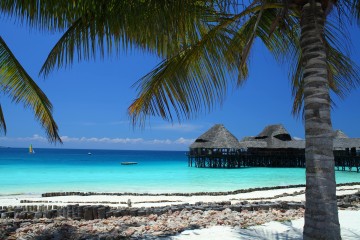
Magical Zanzibar
A mesmerizing week-long adventure in the tropical paradise of Zanzibar. The perfect add-on to your safari adventure!

Laura Pattara | 29 August 2023
With credit to Tara SutherlandEmbarking on a safari in Tanzania is undeniably one of the world's most epic travel experiences. The country is tailor-made for living out your dream 'National Geographic style' safari thanks to its incredible array of game reserves, concentration of iconic African wildlife, array of lodges and bevvy of distinctive ecosystems.
Pinning down Tanzania for your safari experience is an easy decision. Choosing which park to visit, when to go and what else to include in your Tanzania travel itinerary, however, isn’t as easy.
In this Ultimate Tanzania Safari Guide, we serve up all the essential info and tips you need to plan an unforgettable safari experience in the heart of eastern Africa. We'll cover what to wear and pack, the best time to go, top safari destinations, cost considerations, offer a Tanzania vs Kenya comparison (in case you wish to combine the two destinations), and safari booking tips to boot.
Moreover, because highlights in Tanzania stretch beyond the safari experience, we'll delve into the country's other extraordinary must-see and do, including climbing Mount Kilimanjaro and spending a few gloriously relaxing days on Zanzibar and Mafia islands.
Ready to head off on the safari adventure of a lifetime?
Your Tanzania safari dream trip starts right here!
Here’s all we’ll cover in this guide:
Tanzania boasts incredible national parks and conservation areas. For logistical purposes, the country’s safari destinations are divided into two sections: the northern and southern circuits.
The northern circuit is the most visited and established of the two – and includes the UNESCO-listed Ngorongoro Crater and its incredibly unique ecosystem, and the Serengeti National Park, renowned for its annual wildebeest migration – the largest herd migration on earth.
Nearby are the Lake Manyara National Park, revered for its giant baobabs, and Tarangire National Park, renowned for its impressive pink flamingo population.
These four game reserves offer a stunning overview of Tanzania's diverse ecosystems and abundant wildlife spotting and are typically included in all northern circuit safari itineraries. This is inarguably the best circuit to choose in Tanzania for an excellent chance to spot the Big Five (lion, leopard, rhino, elephant, and buffalo).
On a game drive through the wilds of Tanzania, spotting giant baobab trees rising from the landscape is a magical sight.
Tanzania’s southern circuit is its wildest side, the one that's lesser-known, lesser-visited and less developed. If you're looking for a genuinely off-the-beaten-track safari destination in Tanzania, then the Selous, Mikumi, and Ruaha national parks fit the bill. Usually, these destinations are favoured by return travellers who've already explored and experienced the northern circuit of Tanzania.
The southern circuit boasts plenty of wildlife (especially lions) and stunning landscapes. Yet, the parks here don’t host the Big Five – part of the reason it remains a less-popular safari option in Tanzania.
Tanzania offers fantastic safari opportunities all year round, yet the timing of your visit can impact the kind of wildlife sightings you can enjoy. Generally, the dry season (from June to October) is considered the best time for wildlife viewing as animals gather around water sources. The wildebeest migration occurs around this time, too, and you'll likely spot river crossings in the Serengeti from July to September. This is an unrivalled chance to watch predators in action, something you’d have to be particularly lucky to see on safari.
From March to May, the wet season sees lush landscapes, fewer tourist crowds, and discounted rates, but wildlife can be a tad more challenging to spot. Many discerning travellers prefer off-peak travel to Tanzania’s most popular parks, like the Serengeti, for the sheer pleasure of exploring and wildlife-spotting minus the at-times overwhelming crowds that can converge there in June-September.
Besides, it's worth remembering that Tanzania's varied ecosystems mean one or two areas always enjoy 'ideal' weather. If your Tanzanian safari plan falls outside the primary dry season, get in touch! Our Destination Specialists can advise you on where to go depending on your travel dates and desires.
Safari packages typically include accommodation, meals, park fees, transportation, and professional guide and driver services. They are usually all-inclusive packages that combine all you ever need on safari - things like flights to Tanzania and extra activities (like a hot air balloon ride over the Serengeti) are paid for separately. The overall cost varies wildly depending on the time of year you visit, the parks you wish to see and the level of comfort you'd like to include.
As a general ballpark, however, lower-budget safaris in Tanzania cost around NZ$ 200-400 per person per day, while mid-range trips (with more comfortable accommodation options in beautiful tented camps) range between NZ$ 500 and NZ$ 1,000 per day. Increase your daily budget and you’ll have a bevy of truly luxurious safari options in Tanzania.
The Tanzania vs Kenya safari debate is as old as time itself. Most travellers solve the problem by combining the two destinations into one single, sensational safari experience. Indeed, if you want to experience the best of East Africa on safari, then planning an itinerary that includes both countries is ideal.
But still, the question remains: how different is the safari experience in the two neighbouring countries?
Tanzania is known for its majestic national parks, like the incomparable Serengeti, which is about ten times larger than Kenya's beloved Masai Mara. The Great Migration in the Serengeti is Tanzania's #1 attraction, yet the park is astonishing to visit even outside migration season. Tanzania offers grander landscapes, more space and a more diluted tourist crowd. The country also boasts a more varied geography, meaning every park looks and feels different. That’s usually a winning combination for many travellers.
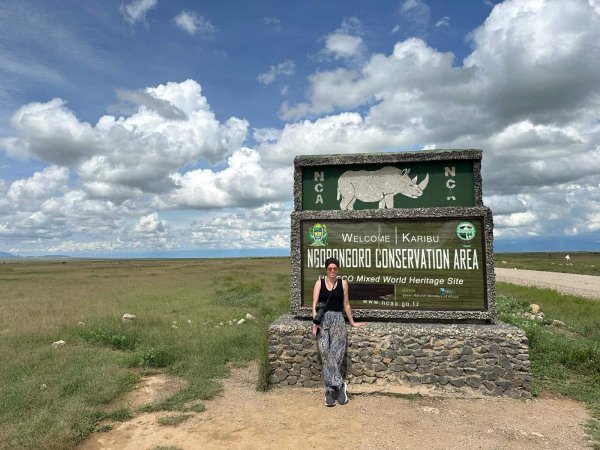
Tanzania's Ngorongoro Crater, one of Africa's Seven Natural Wonders and home to one of the densest concentrations of mammals on the continent.
The Mara is itself an indescribable treasure. Given it's much smaller than the Serengeti, it enjoys a greater density of wildlife so every game drive usually delivers abundant wildlife sightings. There are essentially more animals (and tourists) to see here on a day-to-day basis. If you are on a super-short safari trip of two days, Kenya is the better option. Ironically, Kenya’s Amboseli National Park, one of our absolute favourite places to safari, offers perhaps the best views of Mt Kilimanjaro.
Kenya & Tanzania Wildlife Safari Small Group Tour – see how we combine the best of both worlds.
No matter what time of year you visit Tanzania, always opt for lightweight, breathable, and neutral-coloured clothing. Choose long-sleeved shirts, pants, and shorts and make sure you have options for layering. This is key to coping with varying temperatures throughout the day – it can get quite cold on those sunrise game drives, yet, within an hour of the sun being up, you'll be peeling your layers off pronto.
Don't forget to pack a wide-brimmed hat, sunglasses, comfortable walking shoes, and socks to protect against insects. A light jacket or sweater will keep you warm in the evenings. Lastly, don’t forget to pack a swimsuit if your lodge has a pool.
In addition to clothing, there are several essential items to pack for your Tanzania safari. Believe it or not, most safari goers still bring a good quality camera with spare batteries and memory cards! We suggest you do the same – don’t rely on your smartphone if you hope to capture outstanding photos of the incredible wildlife and landscapes on safari. This is perhaps the last place on earth where not even the latest I-phone can do it justice.
Pack binoculars to enhance your wildlife viewing experience and expect to share them around as many people simply forget to pack them. Other essential items include sunscreen, insect repellent, a first aid kit, and a refillable water bottle.
Booking a Tanzania safari independently is logistically challenging and rarely turns out cheaper anyway. When talking about a journey that's at the mercy of the weather or transport gods at every step of the way, it helps to have an agency that has an overview of your needs and can solve problems quickly. To ensure everything runs smoothly – from airport transfers to lodge transport and daily safari game drives, go with a reputable tour operator with a proven track record, experienced and passionate guides, and a commitment to sustainable tourism practices.
The most critical factors are group size (the smaller, the better), vehicle quality (must be reliable) and itinerary customisation options. Booking in advance is advisable, especially during peak seasons. Most travellers book their Tanzania safaris up to a year in advance, which grants you the greatest choice of accommodation. If you have your heart set on a special place, like the uber-famous 5* Giraffe Manor in Kenya, do note that it’s not unheard of for them to be fully booked out two years in advance.
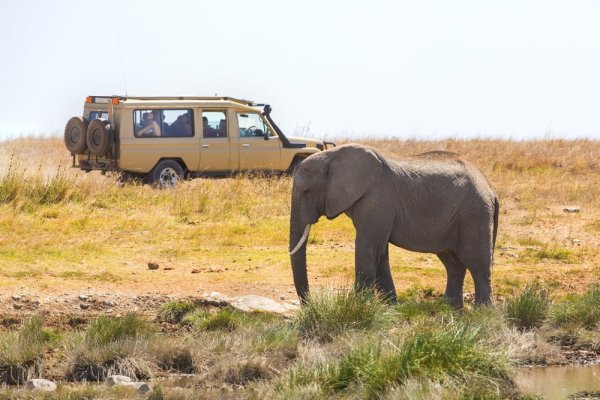
African elephant grazing near safari vehicle.
See our Essence of Tanzania Small Group Tour – fewer people per group means more personalized attention and a more intimate safari experience overall.
A safari is undoubtedly a reason alone to head to Tanzania. But, since you're here, wouldn't you love to discover more of the country's other incredible highlights? Whether you’re into mountain climbing, beach-combing, SCUBA diving or historical sightseeing, you’ll find your ideal safari add-on experience.
Tanzania is home to Africa’s highest peak, Mt Kilimanjaro, one of Africa's most photographed landmarks. The stunning dormant volcano rises almost 6,000 metres above sea level and is the most coveted climbing destination on the continent. Climbing Kili is a feat of endurance, although it isn't a technical climb, and is open to beginner mountaineers and experienced trekkers. You need about 7-10 days, a decent fitness level and a professional guide and team to comfortably and safely climb Mt Kili.
If a 'head-spinning mountain hike' isn't up your alley and you'd much rather end your safari with a few days of R&R on a glorious stretch of beach, Zanzibar may be more to your liking. The idyllic archipelago is a short ferry ride from Dar es Salaam. It is revered for boasting some of Africa’s dreamiest beaches, where blinding white coral sand meets the Indian Ocean’s warm, turquoise seas. This is the most popular post-safari escape in Tanzania and for good reason. Zanzibar isn’t just a convenient and relaxing destination – this is one of Africa’s most jaw-dropping treasures.
See our Magical Zanzibar 8-day tour – the perfect add-on to a safari in Tanzania.
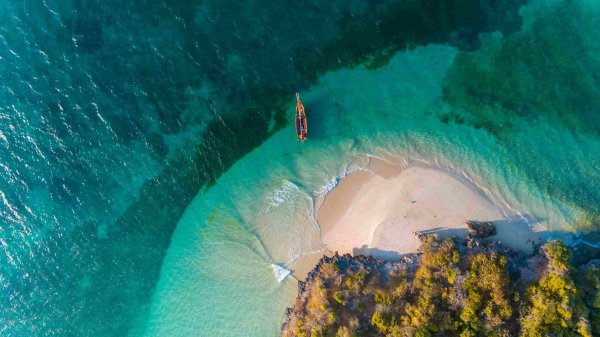
Zanzibar is Eastern Africa’s most revered destination for a spot of beachside R&R.
Zanzibar’s main island, Unguja, is also home to one of Africa’s last remaining historic town centres. For over 1,000 years, Stone Town was East Africa’s hub of silk, spice and slave trading; today, the UNESCO-listed maze of cobbled streets still boasts a fascinating fusion of African, Arabian, Indian and European influences. History buffs should consider spending at least two nights in Stone Town to visit its most prominent historical and cultural sites before moving to a seaside resort. Watching the sunset from one of Stone Town’s rooftop restaurants is a truly unforgettable experience.
If you’re looking for a quieter island getaway, Mafia Island offers pristine coral reefs and the opportunity to swim with whale sharks, particularly from October to February. The Mafia archipelago encompasses a protected marine park and offers a different island experience to Zanzibar. Development has been kept at a minimum here, so expect an immersive nature-based stay, a glorious array of seaside lodges from which to choose, world-class seafood and some of the best snorkelling and diving in all of Africa.
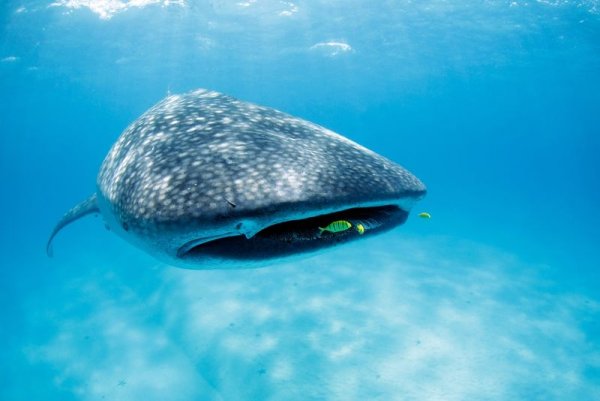
The Mafia archipelago is one of the best destinations to swim with whale sharks in Africa.
A Tanzania safari is the kind of once-in-a-lifetime experience that’ll make you pinch yourself for years to come. With a little prep and lots of experienced advice from Viva’s Destination Specialists, you can turn those safari dreams into reality.
Contact us to learn more about planning the perfect safari trip in Tanzania.
Laura PattaraLaura Pattara has guided overland trips across Africa and now focuses her writing on the continent for Viva Expeditions. She once camped beneath a marula tree that an elephant tore apart during the night, yet somehow she still sleeps best in a tent. But make it glam! From sunrise balloon rides over the Serengeti to following the rhythms of wildlife migrations, Laura brings the wild heart of Africa to life with warmth, depth, and the occasional muddy boot. |

A mesmerizing week-long adventure in the tropical paradise of Zanzibar. The perfect add-on to your safari adventure!
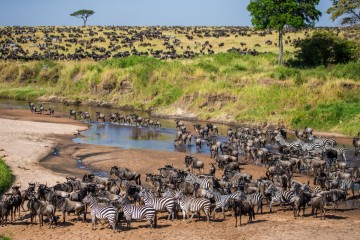
Small Group Tours: Embark on an escorted small group tour to discover the stunning continents of South America, Africa, Antarctica and New Zealand. A group tour gives you the opportunity to explore in a fun and exciting environment surrounded by like-minded travellers.
Discover Tanzania's wild spirit on this small group safari, from Tarangire's elephants to the renowned Ngorongoro Crater and Serengeti.
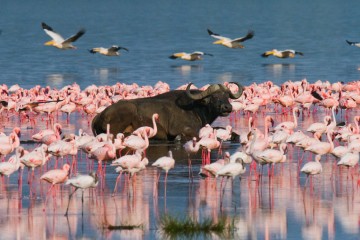
Small Group Tours: Embark on an escorted small group tour to discover the stunning continents of South America, Africa, Antarctica and New Zealand. A group tour gives you the opportunity to explore in a fun and exciting environment surrounded by like-minded travellers.
This unique safari adventure seamlessly blends captivating cultures, breathtaking scenery, and an exceptional chance to encounter the Big-5 wildlife.